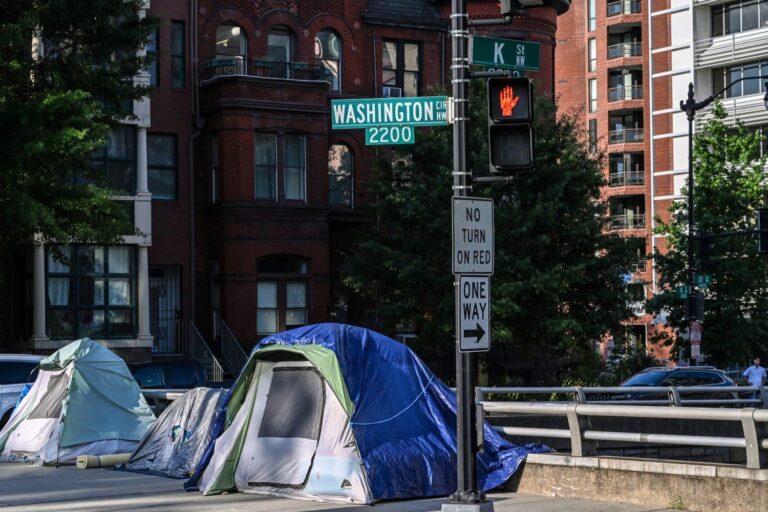Washington, D.C. Escalates Homeless Encampment Clearances Under Federal Scrutiny
In response to increasing federal demands, Washington, D.C. officials have ramped up efforts to clear homeless encampments throughout the city. This intensified initiative includes more frequent patrols and organized removal operations targeting sprawling tent communities in public areas. Authorities cite concerns over public health, safety, and sanitation as primary motivators for these actions. However, this approach has sparked debate among community members and advocates, who caution that forcibly displacing homeless individuals without sufficient housing options may exacerbate their hardships.
Key components of the current strategy include:
- Systematic dismantling of tents and confiscation of personal belongings in public spaces
- Efforts to transition displaced individuals into temporary shelters or social service programs
- Strengthened collaboration between municipal agencies, federal bodies, and nonprofit organizations
| Agency | Function | Recent Initiatives |
|---|---|---|
| DC Housing Authority | Emergency shelter provision | Expanded shelter capacity by 15% in 2024 |
| DC Metropolitan Police | Enforcement and area patrols | Completed over 30 encampment clearance operations this year |
| Federal Homelessness Task Force | Oversight and funding allocation | Disbursed $2 million toward crisis intervention programs |
Advocates Spotlight Deficiencies in Support Services and Humanitarian Risks
Community leaders and homeless advocates argue that the city’s intensified encampment removals overlook the underlying causes of homelessness and risk further destabilizing an already vulnerable population. They emphasize the critical shortage of comprehensive support services, including mental health care, substance abuse treatment, and affordable housing options. Many express concern that enforcement actions are being carried out without sufficient investment in these essential resources, potentially leading to increased displacement and trauma among homeless individuals.
Key shortcomings identified by advocates include:
- Inadequate transitional shelter availability to accommodate those displaced by clearances
- Absence of coordinated case management to provide continuous care and support
- Limited collaboration with grassroots organizations that have historically delivered frontline assistance
| Challenge | Consequences | Advocate Recommendations |
|---|---|---|
| Encampment Disbandment | Displacement without stable housing alternatives | Expand affordable housing programs and permanent supportive housing |
| Insufficient Support Services | Increase in untreated mental health and addiction issues | Boost funding for health and social service initiatives |
| Enforcement-Centric Approach | Growing mistrust between homeless individuals and authorities | Promote community engagement and trust-building efforts |
Developing Sustainable Solutions for Homelessness Amid Political and Social Complexities
Washington, D.C. continues to grapple with the multifaceted challenge of homelessness, especially as political pressures mount following outspoken criticism from former President Donald Trump. While clearing encampments may temporarily improve public spaces, experts warn that such measures do not resolve the systemic issues driving homelessness. Advocates call for integrated, long-term strategies that combine affordable housing development, expanded mental health and addiction services, and employment support to break the cycle of homelessness.
Addressing these challenges requires overcoming social stigmas and fostering cooperation among government agencies, nonprofits, and community stakeholders. A comprehensive approach should include:
- Permanent supportive housing models that embed social services within residential programs
- Increased investment in addiction recovery and mental health treatment facilities
- Job training and placement initiatives tailored to the needs of homeless individuals
- Policy reforms encouraging the expansion of affordable housing stock
Implementing a data-driven framework to monitor progress is essential. The following table outlines key performance indicators to assess the effectiveness of long-term homelessness interventions:
| Metric | Measurement | Target |
|---|---|---|
| Housing Retention | Average duration housed without eviction | At least 12 months |
| Employment Rate | Percentage of formerly homeless individuals employed | 60% or higher |
| Mental Health Service Access | Proportion receiving consistent care | 75% or more |
Policy Recommendations for Integrating Public Safety with Housing Stability
Crafting effective homelessness policies requires balancing enforcement with compassion to protect public safety while respecting the dignity of those experiencing homelessness. A holistic strategy can address both immediate concerns and long-term needs. Recommended approaches include:
- Establishing low-barrier shelters: Facilities that offer safe, accessible, and immediate refuge without stringent entry requirements
- Fostering community partnerships: Collaborations with nonprofits, faith-based groups, and advocates to deliver personalized outreach and support
- Investing in affordable housing: Expanding housing options coupled with wraparound services such as mental health care and vocational training
Utilizing data-driven resource allocation can help municipalities balance enforcement with empathetic interventions. The table below compares outcomes from cities employing different homelessness management strategies:
| City | Strategy | Impact on Public Safety | Housing Stability Improvement |
|---|---|---|---|
| City X | Encampment Removal + Shelter Expansion | Moderate reduction in minor crimes | 10% decrease in chronic homelessness |
| City Y | Housing First Model + Outreach | Significant drop in public disturbances | 25% increase in permanent housing placements |
| City Z | Strict Enforcement Only | Short-term decline in reported incidents | No significant housing improvements |
These findings suggest that combining supportive services with targeted enforcement yields better outcomes in both public safety and housing stability. Policymakers are encouraged to adopt collaborative frameworks that empower homeless individuals rather than relying solely on punitive measures.
Conclusion: Navigating the Complexities of Homelessness Policy in Washington, D.C.
As Washington, D.C. confronts the escalating homelessness crisis, the city’s recent push to dismantle encampments reflects the intricate challenges urban leaders face. Under heightened federal scrutiny, including vocal criticism from former President Donald Trump, local officials strive to reconcile public safety priorities with the urgent need for compassionate, comprehensive support systems. The evolving situation underscores the necessity for sustainable, multifaceted solutions that address both immediate concerns and the systemic roots of homelessness in the nation’s capital.







